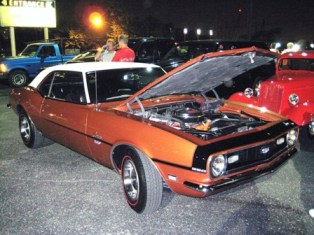Under The Hood
 Service Station Procedures
Service Station Procedures
1968 Camaro at the 2008 Street Rod Nationals in Louisville, Ky. This car belongs to a friend of mine. His dad and all of his brothers are were always involved in cars. Some of what I learned was in their driveway when I was growing up. So this is a great opening to this segment of checking under the hood.
OIL CHECK
When to check the oil: If you think about it, you can drive about 400 miles on a tank of gas. At each fill-up check your car's oil level.
Wait a few minutes after turning the engine off before you check the oil.
Step 1. Remove the dipstick. In my car the dipstick has a orange handle, but this is not true with all cars.
Step 2. Wipe the dipstick with a clean cloth or paper towel.
Step 3. Insert the dip stick all the way back in its hole.
Step 4. Remove the dipstick again and look at the end of the stick. The level of the oil should be between the lower and upper marks.
If the oil level is near or below the lower mark, add oil to your engine.
As always, every car owner should reference the owner's manual for specific oil check and add oil procedures.
Cooling System
This will hurt you. Never open, service or drain the radiator or cooling system when the engine is hot; serious burns can occur from the steam and hot coolant.
Engines generate heat and lots of it. Heat is absorbed by the engine: soaked up by its pistons, cylinder heads, valves and other parts. None of these components can take unlimited heat. They've got to be continuously cooled; otherwise, they'll weaken and catastrophically fail. So as fast as combustion puts heat into these components, it's up to the engine's cooling system to take it out and dump it.
If a engine overheats half of its life is lost. Or worse, total failure. So check your fluid level and watch your temperature gauge. If your engine shows signs of overheating or running hot shut it down!
When you check your engine oil, look at the cooling system reservoir. If the fluid is below the min mark, then add coolant. Check your owner's manual for the specific type of coolant for your car. There are different types of coolant, so if you are unsure check the specs first.
Drive Belts
When a belt breaks it is game over. You are going to be stranded. This is something you never want to happen to your family. Belts never break without warning. Pay attention to the warning signs.
The maintenance intervals suggested by manufacturers vary by time, operating conditions (normal or heavy), and mileage. A good rule of thumb is to inspect the drive belts every 15,000 miles or 12 months (whichever occurs first).
Inspect the belts for the following signs of damage or wear: glazing, cracking, fraying, crumbling or missing chunks. A glazed belt will be slightly brittle and perfectly smooth from slipping, and may exhibit a screeching noise when the engine is suddenly accelerated or first started. A good belt will have a slight texture of fabric visible and the surface should be soft and flexible. Cracks will usually start at the inner edge of a belt and run outward. A belt that is fraying will have the fabric backing de-laminating itself from the belt. A belt that is crumbling or missing chunks will have missing pieces in the cross-section of the belt, some times these chunks will be stuck in the pulley groove and not easily seen. All worn or damaged drive belts should be replaced immediately. It is best to replace all drive belts at one time, as a preventive maintenance measure.
Hoses
Among all the equipment in your vehicle, belts and hoses have the shortest lifespan. Due to constant exposure to heat, vibration, and harmful chemicals, these components invariably crack, leak, fray, and peel. If you think of hoses as your vehicle's circulatory system, then you'll have an appropriate representation of how important they are. Channeling car fluids to their correct destination, hoses are composed of two rubber layers with fabric in between.
Visual Inspection of Hoses: Search for clear indications of damage (leaks, cracks, hardening, or softening).
If you smell engine coolant and cannot locate the leak, then seek a pro and get a cooling system test for leaks using pressure technology.
Battery
You are starting your car; listen to the whirling song of the starter cranking the engine. If the tempo sounds just a little slow or the tone just a little low it is a hint that your battery is on its last breath. Checking and maintaining the battery on a fair day is much better than discovering that the battery has checked out on a cold dark night in the far corner of the Wal Mart parking lot. I go to Advance Auto Parts annually in the fall for a free charging system testing and car battery inspection. They test your vehicle's charging system to make sure all its parts are working correctly. Battery load testers determine what kind of shape the battery is in. If the battery shows any weakness I have Advance put in a battery. I try not to run any component on a car to failure. This small investment in time now can save a large amount of time and headache later down the road.
Contributors: Indiucky